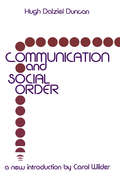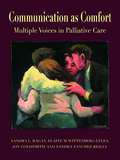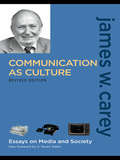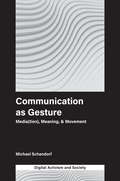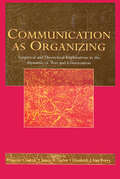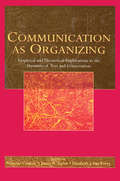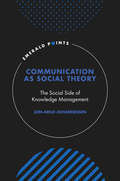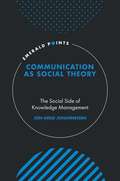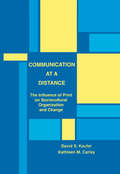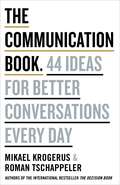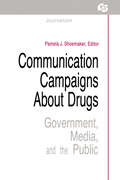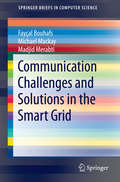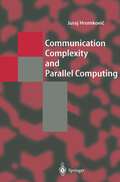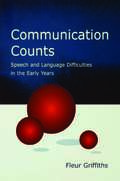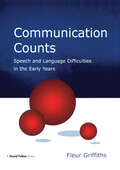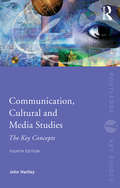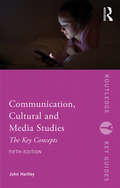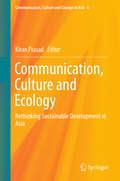- Table View
- List View
Communication and Social Order
by Hugh Dalziel DuncanIn this highly influential study of art forms as models for a theory of communications, Hugh Dalziel Duncan demonstrates that without understanding of the role of symbols in society, social scientists cannot hope to develop adequate models for social analysis. He reviews critically major contributions to communication theory during the past century: Freud's analysis of dream symbolism, Simmel's concept of sociability, James' insights into religious experience, and Dewey's relating of art to experience.
Communication as Comfort: Multiple Voices in Palliative Care (Routledge Communication Series)
by Sandra L. Ragan Elaine M. Wittenberg-Lyles Joy Goldsmith Sandra Sanchez ReillyThis exceptional work explores the complexities of communication at one of the most critical stages of the life experience--during advanced, serious illness and at the end of life. Challenging the predominantly biomedical model that informs much communication between seriously ill and/or dying patients and their physicians, caregivers, and families, Sandra L. Ragan, Elaine M. Wittenberg-Lyles, Joy Goldsmith, and Sandra Sanchez-Reilly pose palliative care--medical care designed to comfort rather than to cure patients--as an antidote to the experience of most Americans at the most vulnerable juncture of their lives. With an author team comprised of three health communication scholars and one physician certified in geriatrics and palliative medicine, this volume integrates the medical literature on palliative care with that of health communication researchers who advocate a biopsychosocial approach to health care. Applying communication theories and insights to illuminate problems and to explain their complexities, the authors advocate a patient-centered approach to care that recognizes and seeks to lessen patients’ suffering and the many types of pain they may experience (physical, psychological, social, and spiritual) during life-threatening illness.
Communication as Comfort: Multiple Voices in Palliative Care (Routledge Communication Series)
by Sandra L. Ragan Elaine M. Wittenberg-Lyles Joy Goldsmith Sandra Sanchez ReillyThis exceptional work explores the complexities of communication at one of the most critical stages of the life experience--during advanced, serious illness and at the end of life. Challenging the predominantly biomedical model that informs much communication between seriously ill and/or dying patients and their physicians, caregivers, and families, Sandra L. Ragan, Elaine M. Wittenberg-Lyles, Joy Goldsmith, and Sandra Sanchez-Reilly pose palliative care--medical care designed to comfort rather than to cure patients--as an antidote to the experience of most Americans at the most vulnerable juncture of their lives. With an author team comprised of three health communication scholars and one physician certified in geriatrics and palliative medicine, this volume integrates the medical literature on palliative care with that of health communication researchers who advocate a biopsychosocial approach to health care. Applying communication theories and insights to illuminate problems and to explain their complexities, the authors advocate a patient-centered approach to care that recognizes and seeks to lessen patients’ suffering and the many types of pain they may experience (physical, psychological, social, and spiritual) during life-threatening illness.
Communication as Culture, Revised Edition: Essays on Media and Society
by James W. CareyIn this classic text, James W. Carey maintains that communication is not merely the transmission of information; reminding the reader of the link between the words "communication" and "community," he broadens his definition to include the drawing-together of a people that is culture. In this context, Carey questions the American tradition of focusing only on mass communication's function as a means of social and political control, and makes a case for examining the content of a communication—the meaning of symbols, not only the motives that originate them or the purposes they serve. He seeks to recast the goal of communication studies, replacing the search for deterministic laws of behavior with a simpler, yet far more challenging mission: "to enlarge the human conversation by comprehending what others are saying." This new edition includes a new critical foreword by G. Stuart Adam that explains Carey's fundamental role in transforming the study of mass communication to include a cultural perspective and connects his classic essays with contemporary media issues and trends. This edition also adds a new, complete bibliography of all of Carey's writings.
Communication as Culture, Revised Edition: Essays on Media and Society
by James W. CareyIn this classic text, James W. Carey maintains that communication is not merely the transmission of information; reminding the reader of the link between the words "communication" and "community," he broadens his definition to include the drawing-together of a people that is culture. In this context, Carey questions the American tradition of focusing only on mass communication's function as a means of social and political control, and makes a case for examining the content of a communication—the meaning of symbols, not only the motives that originate them or the purposes they serve. He seeks to recast the goal of communication studies, replacing the search for deterministic laws of behavior with a simpler, yet far more challenging mission: "to enlarge the human conversation by comprehending what others are saying." This new edition includes a new critical foreword by G. Stuart Adam that explains Carey's fundamental role in transforming the study of mass communication to include a cultural perspective and connects his classic essays with contemporary media issues and trends. This edition also adds a new, complete bibliography of all of Carey's writings.
Communication as Gesture: Media(tion), Meaning, & Movement (Digital Activism and Society: Politics, Economy and Culture in Network Communication)
by Michael SchandorfWhile the concept of communication has long been bound to a reductive model of the exchange of information, very few scholars of communication would argue that these assumptions are realistic, without a long list of qualifying caveats. But the concept of communication, built from the integration of semiotic signification with the idea of information as the 'carrier' of transmitted meaning, is so deeply ingrained and simple that even displacing it can seem futile, if not absurd. Nevertheless, these foundational assumptions tightly constrain the ways in which any interactional phenomena can be conceived--and constraints upon our ways of understanding communication drastically limit our capacity to understand our worlds and the social processes that generate them, at any scale or level of abstraction. Communication as Gesture traces the concept of communication from its roots in classical rhetoric to its integration in structural linguistics, semiotics, information theory, and cybernetics, integrating perspectives from contemporary rhetorical theory, relational psychology, interactional sociology, philosophy, cognitive linguistics, discourse studies, multimodal semiotics, and more. Because so much of our contemporary world is lived with and through digital media technologies, the study of new media and social media provides a rich illustration of the constraints imposed by our reductive assumptions--and hints at the possibilities generated by rethinking them. The gesture theory of communication introduced presents a dimensional account of communication that is intuitively accessible and theoretically rich while overturning reductive assumptions of the linear character of interaction.
Communication as Gesture: Media(tion), Meaning, & Movement (Digital Activism and Society: Politics, Economy and Culture in Network Communication)
by Michael SchandorfWhile the concept of communication has long been bound to a reductive model of the exchange of information, very few scholars of communication would argue that these assumptions are realistic, without a long list of qualifying caveats. But the concept of communication, built from the integration of semiotic signification with the idea of information as the 'carrier' of transmitted meaning, is so deeply ingrained and simple that even displacing it can seem futile, if not absurd. Nevertheless, these foundational assumptions tightly constrain the ways in which any interactional phenomena can be conceived--and constraints upon our ways of understanding communication drastically limit our capacity to understand our worlds and the social processes that generate them, at any scale or level of abstraction. Communication as Gesture traces the concept of communication from its roots in classical rhetoric to its integration in structural linguistics, semiotics, information theory, and cybernetics, integrating perspectives from contemporary rhetorical theory, relational psychology, interactional sociology, philosophy, cognitive linguistics, discourse studies, multimodal semiotics, and more. Because so much of our contemporary world is lived with and through digital media technologies, the study of new media and social media provides a rich illustration of the constraints imposed by our reductive assumptions--and hints at the possibilities generated by rethinking them. The gesture theory of communication introduced presents a dimensional account of communication that is intuitively accessible and theoretically rich while overturning reductive assumptions of the linear character of interaction.
Communication as Organizing: Empirical and Theoretical Explorations in the Dynamic of Text and Conversation (Routledge Communication Series)
by François Cooren James R. Taylor Elizabeth J. Van EveryCommunication as Organizing unites multiple reflections on the role of language under a single rubric: the organizing role of communication. Stemming from Jim Taylor's earlier work, The Emergent Organization: Communication as Its Site and Surface (LEA, 2000), the volume editors present a communicational answer to the question, "what is an organization?" through contributions from an international set of scholars and researchers. The chapter authors synthesize various lines of research on constituting organizations through communication, describing their explorations of the relation between language, human practice, and the constitution of organizational forms. Each chapter develops a dimension of the central theme, showing how such concepts as agency, identity, sensemaking, narrative and account may be put to work in discursive analysis to develop effective research into organizing processes. The contributions employ concrete examples to show how the theoretical concepts can be employed to develop effective research. This distinctive volume encourages readers to discover and develop a truly communicational means of addressing the question of organization, addressing how organization itself emerges in the course of communicational transactions. In presenting a single and entirely communicational perspective for exploring organizational phenomena, grounded in the discourse of communicational transactions and the establishment of relationships through language, it is required reading for scholars, researchers, and graduate students working in organizational communication, management, social psychology, pragmatics of language, and organizational studies.
Communication as Organizing: Empirical and Theoretical Explorations in the Dynamic of Text and Conversation (Routledge Communication Series)
by Francois Cooren James R. Taylor Elizabeth J. Van EveryCommunication as Organizing unites multiple reflections on the role of language under a single rubric: the organizing role of communication. Stemming from Jim Taylor's earlier work, The Emergent Organization: Communication as Its Site and Surface (LEA, 2000), the volume editors present a communicational answer to the question, "what is an organization?" through contributions from an international set of scholars and researchers. The chapter authors synthesize various lines of research on constituting organizations through communication, describing their explorations of the relation between language, human practice, and the constitution of organizational forms. Each chapter develops a dimension of the central theme, showing how such concepts as agency, identity, sensemaking, narrative and account may be put to work in discursive analysis to develop effective research into organizing processes. The contributions employ concrete examples to show how the theoretical concepts can be employed to develop effective research. This distinctive volume encourages readers to discover and develop a truly communicational means of addressing the question of organization, addressing how organization itself emerges in the course of communicational transactions. In presenting a single and entirely communicational perspective for exploring organizational phenomena, grounded in the discourse of communicational transactions and the establishment of relationships through language, it is required reading for scholars, researchers, and graduate students working in organizational communication, management, social psychology, pragmatics of language, and organizational studies.
Communication as Social Theory: The Social Side of Knowledge Management (Emerald Points)
by Jon-Arild JohannessenCommunication as Social Theory: The Social Side of Knowledge Management develops a social theory at micro level, with communication as the essential social mechanism within the theory. Leadership expert Johannessen examines how we can advance communication as social theory. The communicative process has been framed as a sequence: select-create-detect. The 'select' element occurs when a positive choice to communicate something is made, thereby deselecting something else. In this book 44 case letters have been developed. These case letters are designed to deepen, underline and augment the 44 conceptual and empirical propositions that have been established. The core message is to promote change in social systems by focusing on changing micro-behaviours. In complex adaptable systems, the individual actors adapt their behaviour to each other on the basis of the local minimal rules. This means that one cannot take individual behaviour for granted, but one must instead investigate individual behaviour within specific contexts. For students of Management Studies and professionals in Leadership this work is a must for expanding their understanding.
Communication as Social Theory: The Social Side of Knowledge Management (Emerald Points)
by Jon-Arild JohannessenCommunication as Social Theory: The Social Side of Knowledge Management develops a social theory at micro level, with communication as the essential social mechanism within the theory. Leadership expert Johannessen examines how we can advance communication as social theory. The communicative process has been framed as a sequence: select-create-detect. The 'select' element occurs when a positive choice to communicate something is made, thereby deselecting something else. In this book 44 case letters have been developed. These case letters are designed to deepen, underline and augment the 44 conceptual and empirical propositions that have been established. The core message is to promote change in social systems by focusing on changing micro-behaviours. In complex adaptable systems, the individual actors adapt their behaviour to each other on the basis of the local minimal rules. This means that one cannot take individual behaviour for granted, but one must instead investigate individual behaviour within specific contexts. For students of Management Studies and professionals in Leadership this work is a must for expanding their understanding.
Communication at A Distance: The Influence of Print on Sociocultural Organization and Change (Routledge Communication Series)
by David S. Kaufer Kathleen M. CarleyThis book bridges an important gap between two major approaches to mass communication -- historical and social scientific. To do so, it employs a theory of communication that unifies social, cultural and technological concerns into a systematic and formal framework that is then used to examine the impact of print within the larger socio-cultural context and across multiple historical contexts. The authors integrate historical studies and more abstract formal representations, achieving a set of logically coherent and well-delimited hypotheses that invite further exploration, both historically and experimentally. A second gap that the book addresses is in the area of formal models of communication and diffusion. Such models typically assume a homogeneous population and a communication whose message is abstracted from the complexities of language processing. In contrast, the model presented in this book treats the population as heterogeneous and communications as potentially variable in their content as they move across speakers or readers. Written to address and overcome many of the disciplinary divisions that have prevented the study of print from being approached from the perspective of a unified theory, this book employs a focused interdisciplinary position that encompasses several domains. It shows the underlying compatibility between cognitive and social theory; between the study of language and cognition and the study of technology; between the postmodern interest in the instability of meaning and the social science interest in the diffusion of information; between the effects of technology and issues of cultural homogeneity and heterogeneity. Overall, this book reveals how small, relatively non-interactive, disciplinary-specific conversations about print are usefully conceived of as part of a larger interdisciplinary inquiry.
Communication at A Distance: The Influence of Print on Sociocultural Organization and Change (Routledge Communication Series)
by David S. Kaufer Kathleen M. CarleyThis book bridges an important gap between two major approaches to mass communication -- historical and social scientific. To do so, it employs a theory of communication that unifies social, cultural and technological concerns into a systematic and formal framework that is then used to examine the impact of print within the larger socio-cultural context and across multiple historical contexts. The authors integrate historical studies and more abstract formal representations, achieving a set of logically coherent and well-delimited hypotheses that invite further exploration, both historically and experimentally. A second gap that the book addresses is in the area of formal models of communication and diffusion. Such models typically assume a homogeneous population and a communication whose message is abstracted from the complexities of language processing. In contrast, the model presented in this book treats the population as heterogeneous and communications as potentially variable in their content as they move across speakers or readers. Written to address and overcome many of the disciplinary divisions that have prevented the study of print from being approached from the perspective of a unified theory, this book employs a focused interdisciplinary position that encompasses several domains. It shows the underlying compatibility between cognitive and social theory; between the study of language and cognition and the study of technology; between the postmodern interest in the instability of meaning and the social science interest in the diffusion of information; between the effects of technology and issues of cultural homogeneity and heterogeneity. Overall, this book reveals how small, relatively non-interactive, disciplinary-specific conversations about print are usefully conceived of as part of a larger interdisciplinary inquiry.
The Communication Book: 44 Ideas for Better Conversations Every Day
by Roman Tschäppeler Mikael KrogerusThe authors of the international bestseller The Decision Book teach us how to communicate better at work and in everyday lifeThe internationally bestselling duo Mikael Krogerus and Roman Tschäppeler have tested the 44 most important communication theories - from Aristotle's thoughts on presenting through Proust on asking questions to the Harvard Negotiation Project - for their practicality in daily business life. In The Communication Book they distil them into a single volume that in their winning way turns seemingly difficult ideas into clear and entertaining diagrams.From running better meetings and improving the conversations in your head to brushing up on your listening skills and small talk, the pair masterfully fuses theoretical knowledge and business advice with humour and practicality. They show that we can improve not only what we communicate, but how we do so. Whether you're a CEO or starting out - or want to improve your relationships at home - this smartly-illustrated and compact guide will improve your communication skills and help you form more meaningful connections at work, while smiling too.
Communication Campaigns About Drugs: Government, Media, and the Public (Routledge Communication Series)
by Pamela J. ShoemakerPublished in 1989, Communication Campaigns About Drugs is a valuable contribution to the field of Communication Studies.
Communication Campaigns About Drugs: Government, Media, and the Public (Routledge Communication Series)
by Pamela J. ShoemakerPublished in 1989, Communication Campaigns About Drugs is a valuable contribution to the field of Communication Studies.
Communication Challenges and Solutions in the Smart Grid (SpringerBriefs in Computer Science)
by Fayҫal Bouhafs Michael Mackay Madjid MerabtiThis SpringerBrief discusses the rise of the smart grid from the perspective of computing and communications. It explains how current and next-generation network technology and methodologies help recognize the potential that the smart grid initiative promises. Chapters provide context on the smart grid before exploring specific challenges related to communication control and energy management. Topics include control in heterogeneous power supply, solutions for backhaul and wide area networks, home energy management systems, and technologies for smart energy management systems. Designed for researchers and professionals working on the smart grid, Communication Challenges and Solutions in the Smart Grid offers context and applications for the common issues of this developing technology. Advanced-level students interested in networking and communications engineering will also find the brief valuable.
Communication Complexity and Parallel Computing (Texts in Theoretical Computer Science. An EATCS Series)
by Juraj HromkovičThe communication complexity of two-party protocols is an only 15 years old complexity measure, but it is already considered to be one of the fundamen tal complexity measures of recent complexity theory. Similarly to Kolmogorov complexity in the theory of sequential computations, communication complex ity is used as a method for the study of the complexity of concrete computing problems in parallel information processing. Especially, it is applied to prove lower bounds that say what computer resources (time, hardware, memory size) are necessary to compute the given task. Besides the estimation of the compu tational difficulty of computing problems the proved lower bounds are useful for proving the optimality of algorithms that are already designed. In some cases the knowledge about the communication complexity of a given problem may be even helpful in searching for efficient algorithms to this problem. The study of communication complexity becomes a well-defined indepen dent area of complexity theory. In addition to a strong relation to several funda mental complexity measures (and so to several fundamental problems of com plexity theory) communication complexity has contributed to the study and to the understanding of the nature of determinism, nondeterminism, and random ness in algorithmics. There already exists a non-trivial mathematical machinery to handle the communication complexity of concrete computing problems, which gives a hope that the approach based on communication complexity will be in strumental in the study of several central open problems of recent complexity theory.
Communication Counts: Speech and Language Difficulties in the Early Years
by Fleur GriffithsProfessionals in early years settings can use this book to focus on ways in which they can work collaboratively with colleagues, in order to help children with communication difficulties to understand and express themselves more fully. It brings together the most useful examples of good practice and draws on the work of reflective practitioners. There are many illustrative case studies provided and it discusses how to observe children's daily interactions, ways in which such observations can be used to improve communication skills; how play can be an important part of improvement; behavior management and support; and literacy development. The practical applications are highlighted throughout the book and the advice given comes directly from those working in early years settings. It should be of great interest to all nursery teachers, teaching assistants, speech and language therapists and parents wishing to play an active part in their children's development of language and communication skills.
Communication Counts: Speech and Language Difficulties in the Early Years
by Fleur GriffithsProfessionals in early years settings can use this book to focus on ways in which they can work collaboratively with colleagues, in order to help children with communication difficulties to understand and express themselves more fully. It brings together the most useful examples of good practice and draws on the work of reflective practitioners. There are many illustrative case studies provided and it discusses how to observe children's daily interactions, ways in which such observations can be used to improve communication skills; how play can be an important part of improvement; behavior management and support; and literacy development. The practical applications are highlighted throughout the book and the advice given comes directly from those working in early years settings. It should be of great interest to all nursery teachers, teaching assistants, speech and language therapists and parents wishing to play an active part in their children's development of language and communication skills.
Communication, Cultural and Media Studies: The Key Concepts (Routledge Key Guides)
by John HartleyThis fourth edition of Communication, Cultural and Media Studies: The Key Concepts is an indispensible guide to the most important terms in the field. It offers clear explanations of the key concepts, exploring their origins, what they’re used for and why they provoke discussion. The author provides a multi-disciplinary explanation and assessment of the key concepts, from ‘authorship’ to ‘censorship’; ‘creative industries’ to ‘network theory’; ‘complexity’ to ‘visual culture’. The new edition of this classic text includes: Over 200 entries including 50 new entries All entries revised, rewritten and updated Coverage of recent developments in the field Insight into interactive media and the knowledge-based economy A fully updated bibliography with 400 items and suggestions for further reading throughout the text
Communication, Cultural and Media Studies: The Key Concepts (Routledge Key Guides)
by John HartleyThis fourth edition of Communication, Cultural and Media Studies: The Key Concepts is an indispensible guide to the most important terms in the field. It offers clear explanations of the key concepts, exploring their origins, what they’re used for and why they provoke discussion. The author provides a multi-disciplinary explanation and assessment of the key concepts, from ‘authorship’ to ‘censorship’; ‘creative industries’ to ‘network theory’; ‘complexity’ to ‘visual culture’. The new edition of this classic text includes: Over 200 entries including 50 new entries All entries revised, rewritten and updated Coverage of recent developments in the field Insight into interactive media and the knowledge-based economy A fully updated bibliography with 400 items and suggestions for further reading throughout the text
Communication, Cultural and Media Studies: The Key Concepts (Routledge Key Guides)
by John HartleyNow in its fifth edition, this pioneering volume of Routledge’s ‘Key Concepts’ series offers clear explanations of key concepts, showing where they came from, what they are used for, and why they provoke discussion or disagreement. The new edition is extensively revised to keep pace with rapidly evolving developments in communication, culture and media, providing topical and authoritative guidance to transformational shifts from broadcast to digital technologies, national to global media and disciplinary to diverse knowledge. It includes: Nearly 250 entries, covering what and how to study across this multi-disciplinary field 50 new entries: from algorithm and assemblage, dance and data, to woke and worldbuilding Updated references with 500 items and suggestions for further reading Revisions, updates and examples throughout. For students and seasoned scholars alike, Communication, Cultural and Media Studies is an invaluable resource in an ever-changing landscape.
Communication, Cultural and Media Studies: The Key Concepts (Routledge Key Guides)
by John HartleyNow in its fifth edition, this pioneering volume of Routledge’s ‘Key Concepts’ series offers clear explanations of key concepts, showing where they came from, what they are used for, and why they provoke discussion or disagreement. The new edition is extensively revised to keep pace with rapidly evolving developments in communication, culture and media, providing topical and authoritative guidance to transformational shifts from broadcast to digital technologies, national to global media and disciplinary to diverse knowledge. It includes: Nearly 250 entries, covering what and how to study across this multi-disciplinary field 50 new entries: from algorithm and assemblage, dance and data, to woke and worldbuilding Updated references with 500 items and suggestions for further reading Revisions, updates and examples throughout. For students and seasoned scholars alike, Communication, Cultural and Media Studies is an invaluable resource in an ever-changing landscape.
Communication, Culture and Ecology: Rethinking Sustainable Development in Asia (Communication, Culture and Change in Asia #6)
by Kiran PrasadThis book offers comprehensive insights into the cultural and ecological values that influence sustainable development across Asia, addressing the cultural, religious and philosophical moorings of development through participatory and grassroots communication approaches. It presents a range of contributions and case studies from leading experts in Asia to highlight the debates on environmental communication and sustainable development that are relevant today, and to provide an overview of the positive traditions of ecological sensitivity and cultural communication that may find common ground between communities. This well-researched guide to the dynamic and complex terrain of communication for sustainable development offers uniquely practical perspectives on communication, environment and sustainable development that are of immense value for policy makers, media scholars, development practitioners, researchers and students of communication and media studies.
